|
Snapshots 76-90
Tobias Boykin (1783-1858) was born in Duplin Co., North Carolina, the son of Revolutionary Soldier William Boykin. Tobias removed to South Carolina, married, and had 8 children, the oldest being James (b. 1819). Gggg-grandfather Tobias was a private under Captain William H. Capers in the South Carolina Militia in the War of 1812. In 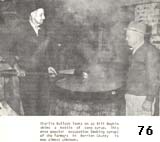 the mid 1850s, Tobias made successful applications for land bounties in Irwin County (in part from which Berrien County, Georgia, was cut), where he had lived since at least 1839. Tobias' son James married Lucinda Tucker and among other children, they had a son John David (b. 1848). John married 18-year-old Julia Ann Luke; they made their home in Berrien Co., and had eight children together before she passed in 1885, leaving him to marry twice again before he departed this life in 1923. Their children were the first of my Boykin kin that I knew. Their second child, my ggrandmother Elizabeth, was born in 1873, and was the second and last wife of my ggrandfather, Samuel W. Watson, who died just two years after his father-in-law. I was 18 when Grandma Betsy died, and 14 when her younger brother Bill (b. 1881, Slide 76) died. Of the siblings, I knew Uncle Bill Boykin best--we always used both names ("Bill Boykin") for reasons that are lost. However, Aunt
Lucinda (b. 1878), Aunt
Malinda (b.1883) and Aunt Mary were around from time to time. Indeed, they periodically came to visit Grandpa (their nephew) and Granny Watson and stayed a week or so each time. They seemed to enjoy it, didn't bother little children, and the rockers on the porch got a good workout, with just a break after lunch when the visitors would take a nap. Although it is just on the dawn of my memory, the three (Grandma Betsy, Aunt Malinda, Aunt Mary) came as a small tribe to visit us when we lived in a little rental house in Willachoochee, Georgia (1952--Daddy was principal for that one year there), and Grandma Betsy came earlier on solo visits to Enigma, Georgia. Of these siblings, though, Aunt Malinda was truly outstanding and made an impression on a young fellow--she was large and loud, but mostly her spirit dominated and cut though her troubles with arthritis. Back to the main thread, Uncle Bill Boykin and his family became my focus of that leg of my family and he hosted family reunions, which sprawled in and out of his house, under his shelters, in fact, all about. As I did at all family reunions, I'd take a look at what Daddy ate and pretty much followed his lead because I knew that he had reconnoitered and identified which pot was brought by whom; he wouldn't eat from just anybody's kitchen. (Being a youngster, I made exceptions for pies and ate whatever and whereever.) In the larger community, Uncle Bill Boykin was well known for his syrup making and it is gratifying that his legacy has been preserved in a short history of our county and on a historical website. His son-in-law, Edgar Bennett, in his 80s at the time of this writing, carries on the tradition, using a vertical cane mill (Kentucky No. 1) and a kettle. Indeed, Edgar himself is a syrupmaking icon in Berrien County! (The photograph was taken from Browning, Sue G.(ed.) (1976) The History of Berrien County, Nashville Printing and Office Supply (Nashville, GA). Parts of the narrative are drawn from Pioneers of Wiregrass Georgia (Vol. 4, 5) op. cit., interviews with Carolyn C. Outlaw and, indirectly, Betty Bennett and referenced websites).
Two other Jamie-Connell images of Uncle Bill (a b ) were shared by Wenda Gaile Bailey. These latter two are posted as large files to enable study of the background. the mid 1850s, Tobias made successful applications for land bounties in Irwin County (in part from which Berrien County, Georgia, was cut), where he had lived since at least 1839. Tobias' son James married Lucinda Tucker and among other children, they had a son John David (b. 1848). John married 18-year-old Julia Ann Luke; they made their home in Berrien Co., and had eight children together before she passed in 1885, leaving him to marry twice again before he departed this life in 1923. Their children were the first of my Boykin kin that I knew. Their second child, my ggrandmother Elizabeth, was born in 1873, and was the second and last wife of my ggrandfather, Samuel W. Watson, who died just two years after his father-in-law. I was 18 when Grandma Betsy died, and 14 when her younger brother Bill (b. 1881, Slide 76) died. Of the siblings, I knew Uncle Bill Boykin best--we always used both names ("Bill Boykin") for reasons that are lost. However, Aunt
Lucinda (b. 1878), Aunt
Malinda (b.1883) and Aunt Mary were around from time to time. Indeed, they periodically came to visit Grandpa (their nephew) and Granny Watson and stayed a week or so each time. They seemed to enjoy it, didn't bother little children, and the rockers on the porch got a good workout, with just a break after lunch when the visitors would take a nap. Although it is just on the dawn of my memory, the three (Grandma Betsy, Aunt Malinda, Aunt Mary) came as a small tribe to visit us when we lived in a little rental house in Willachoochee, Georgia (1952--Daddy was principal for that one year there), and Grandma Betsy came earlier on solo visits to Enigma, Georgia. Of these siblings, though, Aunt Malinda was truly outstanding and made an impression on a young fellow--she was large and loud, but mostly her spirit dominated and cut though her troubles with arthritis. Back to the main thread, Uncle Bill Boykin and his family became my focus of that leg of my family and he hosted family reunions, which sprawled in and out of his house, under his shelters, in fact, all about. As I did at all family reunions, I'd take a look at what Daddy ate and pretty much followed his lead because I knew that he had reconnoitered and identified which pot was brought by whom; he wouldn't eat from just anybody's kitchen. (Being a youngster, I made exceptions for pies and ate whatever and whereever.) In the larger community, Uncle Bill Boykin was well known for his syrup making and it is gratifying that his legacy has been preserved in a short history of our county and on a historical website. His son-in-law, Edgar Bennett, in his 80s at the time of this writing, carries on the tradition, using a vertical cane mill (Kentucky No. 1) and a kettle. Indeed, Edgar himself is a syrupmaking icon in Berrien County! (The photograph was taken from Browning, Sue G.(ed.) (1976) The History of Berrien County, Nashville Printing and Office Supply (Nashville, GA). Parts of the narrative are drawn from Pioneers of Wiregrass Georgia (Vol. 4, 5) op. cit., interviews with Carolyn C. Outlaw and, indirectly, Betty Bennett and referenced websites).
Two other Jamie-Connell images of Uncle Bill (a b ) were shared by Wenda Gaile Bailey. These latter two are posted as large files to enable study of the background. It is interesting to note how our experiences differ and how those experiences flavor our perspectives and attitude. I left home on June 9, 1963, and never 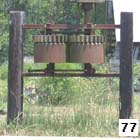 physically returned permanently although my heart was somehow stuck in Berrien Co. (Georgia). At that time, barely 17, I had never heard of pizza, broccoli or cauliflower (but I did know that sugar-cane syrup could be poured on just about any kind of food and improve its flavor). Although I questioned authority, I did not ask many substantive questions and I therefore did not know that anyone had ever powered a cane mill with anything other than an animal and I did not know that the rollers could be arranged in other than a vertical orientation. Although that portion of my ignorance has been eased a little, I still think of cane mills as I knew them from my childhood. These vertical animal-powered cane mills still evoke a strong emotion within me, bringing to mind hard work, honesty, independence and the satisfaction of creating a livihood from one's hard work. This frameless mill (Slide 77), now relegated to yard art, is located on Old South Coffee Road (New Lois Community, Berrien Co., Georgia) and must lift the spirits of many bypassers, especially those of us (Webb, Parish, Devane and others) whose roots go back to this community for more than 150 years, indeed, before the county was formed. physically returned permanently although my heart was somehow stuck in Berrien Co. (Georgia). At that time, barely 17, I had never heard of pizza, broccoli or cauliflower (but I did know that sugar-cane syrup could be poured on just about any kind of food and improve its flavor). Although I questioned authority, I did not ask many substantive questions and I therefore did not know that anyone had ever powered a cane mill with anything other than an animal and I did not know that the rollers could be arranged in other than a vertical orientation. Although that portion of my ignorance has been eased a little, I still think of cane mills as I knew them from my childhood. These vertical animal-powered cane mills still evoke a strong emotion within me, bringing to mind hard work, honesty, independence and the satisfaction of creating a livihood from one's hard work. This frameless mill (Slide 77), now relegated to yard art, is located on Old South Coffee Road (New Lois Community, Berrien Co., Georgia) and must lift the spirits of many bypassers, especially those of us (Webb, Parish, Devane and others) whose roots go back to this community for more than 150 years, indeed, before the county was formed.
The Heritage Farm at the General Coffee State Park (Nicholls,
Georgia) deserves to be on everyone's "drop-by list." At the entrance, one can walk through the well appointed 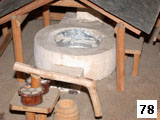 Reihan Cabin (1933), which has a model of the Berryann & Pricilla Wright Floyd homeplace (Broxton, Georgia), including a syrup-making outfit (Slide 78). On moving to the farm (1901), they first lived in the kitchen and then completed everything else within a few years. Interestingly, oxen were used until 1938, when the first mule was acquired. In turn, the mules were displaced by tractors in the mid 1950s. Use of oxen on our family farms predates me, but I remember the double oxen yoke that was kept under one of the pack houses on the old Sam Watson homeplace. The yoke and a whole lot more were taken off when an antique dealer paid a stealthy visit to my grandmother, who was alone, in her in mid-80s, and who suffered from what we would now call dementia. Of course, my mother and her sister, Lucille, were livid, but were able to retrieve only some of the material (e.g., the dinner bell) and block his second visit to pick up more. In one fell swoop this person gutted our family of much of its heritage, something I have vowed never to do to another family, despite my love of old farm equipment. More said would be less and I digress. Anyhow, as mentioned above, vertical animal-powered mills are of interest to me, and I particularly enjoy noting how frameless mills were mounted. Thus, I was grateful to be given special access to a mill donated in the memory of W.L. (Bill) Kirkland by his spouse, Ethel Lewis Kirkland. To see this mill from various angles, click here: 1, 2, 3, 4, 5 . Finally, the park has a fall syrup-making using a Goldens' No. 2 (New Model) mill and 50-gallon kettle. The tour is finished by passing the Meeks Cabin , which is one of South Georgia's oldest buildings (1828, provenance, near Nicholls, Georgia). Reihan Cabin (1933), which has a model of the Berryann & Pricilla Wright Floyd homeplace (Broxton, Georgia), including a syrup-making outfit (Slide 78). On moving to the farm (1901), they first lived in the kitchen and then completed everything else within a few years. Interestingly, oxen were used until 1938, when the first mule was acquired. In turn, the mules were displaced by tractors in the mid 1950s. Use of oxen on our family farms predates me, but I remember the double oxen yoke that was kept under one of the pack houses on the old Sam Watson homeplace. The yoke and a whole lot more were taken off when an antique dealer paid a stealthy visit to my grandmother, who was alone, in her in mid-80s, and who suffered from what we would now call dementia. Of course, my mother and her sister, Lucille, were livid, but were able to retrieve only some of the material (e.g., the dinner bell) and block his second visit to pick up more. In one fell swoop this person gutted our family of much of its heritage, something I have vowed never to do to another family, despite my love of old farm equipment. More said would be less and I digress. Anyhow, as mentioned above, vertical animal-powered mills are of interest to me, and I particularly enjoy noting how frameless mills were mounted. Thus, I was grateful to be given special access to a mill donated in the memory of W.L. (Bill) Kirkland by his spouse, Ethel Lewis Kirkland. To see this mill from various angles, click here: 1, 2, 3, 4, 5 . Finally, the park has a fall syrup-making using a Goldens' No. 2 (New Model) mill and 50-gallon kettle. The tour is finished by passing the Meeks Cabin , which is one of South Georgia's oldest buildings (1828, provenance, near Nicholls, Georgia).
A windfall from being involved in syrupmaking in North Florida is the pleasure of knowing Bobby McDaniel (Sneads, Florida). Fortunately for me, I have been able to visit with Bobby 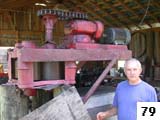 several times at his syrup-making shed, at my house, and at the Pioneer Settlement. On this particular day, Charles Deese was with me, making it more special. And, on this particular day, Bobby gave me a bottle of his pure cane syrup, which provided unambigious proof that Bobby does not need any syrupmaking lessons! Slide 79 shows Bobby with his Goldens' No. 4 (Old Style), which he restored in 2003. The restoration entailed building up the shafts with sleeves and milling them back to size. The speed reducer (ratio 437:1) was made by Link Belt Gear Co. and originally rotated a military radar unit. The gear reducer is coupled to a 5-hp motor (1800 rpm) on the input side and a huge chain (ANSI 160?) on the output side, providing--in the end--a mill rotation of 4 rpm, which Bobby feels is ideal. At the time of this writing, Bobby is reworking a Golden's No. 4xx (New Model). (For a photo of this model mill, click here.) several times at his syrup-making shed, at my house, and at the Pioneer Settlement. On this particular day, Charles Deese was with me, making it more special. And, on this particular day, Bobby gave me a bottle of his pure cane syrup, which provided unambigious proof that Bobby does not need any syrupmaking lessons! Slide 79 shows Bobby with his Goldens' No. 4 (Old Style), which he restored in 2003. The restoration entailed building up the shafts with sleeves and milling them back to size. The speed reducer (ratio 437:1) was made by Link Belt Gear Co. and originally rotated a military radar unit. The gear reducer is coupled to a 5-hp motor (1800 rpm) on the input side and a huge chain (ANSI 160?) on the output side, providing--in the end--a mill rotation of 4 rpm, which Bobby feels is ideal. At the time of this writing, Bobby is reworking a Golden's No. 4xx (New Model). (For a photo of this model mill, click here.)
David White (Blountstown, Florida) did not intend to cause me marital disharmony, but that's neither here nor there. Once I saw his splendid little portable cooker, I realized I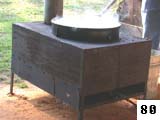 had to have one. (. . . but, at this writing, I have not convinced Nedra.) Let me start at the beginning: David has a trailer-mounted Columbus No. 11 that is powered by a 5-hp electic motor. His speed reduction is accomplished by a 2:1 reduction through a double v-pulley out of his motor to the input of a speed reducer (ratio: 35:1) and is further reduced by a ANSI 60 chain drive. The final mill rpm is 6.8 and his juice output is about 50 gallons per hour. Note that his drive train is flexible--within an hour, he can disconnect the sprocket on the king journal and drive the mill with a mule. Interestingly, David uses nylon bushings. The furnace (Slide 80) that David and his brother Ralph constructed is of black iron plate (24" wide, 36" long, and 16" deep). The opening at the front is 4 " high, sufficient for him to slide in his burner (175,00 BTU burner, from an old hot water heater). He runs the burner at 3-5 psi (high pressure regulator: Agri Supply catalog #36292) and his 6" flue is 5' tall. The 20-gallon washpot cooks off in about an hour and forty minutes. This simple cooker system is really something to see in action, and is all that many of us hobbyists need. had to have one. (. . . but, at this writing, I have not convinced Nedra.) Let me start at the beginning: David has a trailer-mounted Columbus No. 11 that is powered by a 5-hp electic motor. His speed reduction is accomplished by a 2:1 reduction through a double v-pulley out of his motor to the input of a speed reducer (ratio: 35:1) and is further reduced by a ANSI 60 chain drive. The final mill rpm is 6.8 and his juice output is about 50 gallons per hour. Note that his drive train is flexible--within an hour, he can disconnect the sprocket on the king journal and drive the mill with a mule. Interestingly, David uses nylon bushings. The furnace (Slide 80) that David and his brother Ralph constructed is of black iron plate (24" wide, 36" long, and 16" deep). The opening at the front is 4 " high, sufficient for him to slide in his burner (175,00 BTU burner, from an old hot water heater). He runs the burner at 3-5 psi (high pressure regulator: Agri Supply catalog #36292) and his 6" flue is 5' tall. The 20-gallon washpot cooks off in about an hour and forty minutes. This simple cooker system is really something to see in action, and is all that many of us hobbyists need.
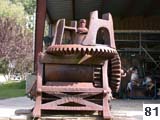 I didn’t hold out much hope of being able to pass by a sign that read “Best Barbeque in Georgia” as I was driving though old Clinton (Georgia). Once inside, I noticed that the proprietor, who was not immediately available, had collected a number of old cash registers. On this basis, I knew he must be a man of substance, so I pleaded with the staff to round him up for me. I was not disappointed in Wayne Coulter; it turned out that just a couple of years earlier a Texas relative had given him a Star Cane Mill (Slide 81; back view; side view). J.A. Fields and Co. made this horizontal mill in three sizes, ranging from 800 to 3000 pounds. (Thanks to Wayne Coulter—who does have excellent barbeque—for driving me over to his home and showing me this mill, to Don Dean who provided information, and to Nedra for her patience with me while I chased down this cane mill.) I didn’t hold out much hope of being able to pass by a sign that read “Best Barbeque in Georgia” as I was driving though old Clinton (Georgia). Once inside, I noticed that the proprietor, who was not immediately available, had collected a number of old cash registers. On this basis, I knew he must be a man of substance, so I pleaded with the staff to round him up for me. I was not disappointed in Wayne Coulter; it turned out that just a couple of years earlier a Texas relative had given him a Star Cane Mill (Slide 81; back view; side view). J.A. Fields and Co. made this horizontal mill in three sizes, ranging from 800 to 3000 pounds. (Thanks to Wayne Coulter—who does have excellent barbeque—for driving me over to his home and showing me this mill, to Don Dean who provided information, and to Nedra for her patience with me while I chased down this cane mill.)
Pat Collins and her husband, Roy Collins, have discovered a way not to retire: set up 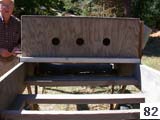 Olde Town (Central, South Carolina). I am afraid that Nedra and I sneaked up on them. They are open only by appointment and since we didn’t get an answer to our ring, we took the chance of “driving by.” Luck was with us; they were hosting an event, which was ending, and they graciously agreed to spend some time with us. In this brief narrative, I can't do justice to the results of their efforts, but offer snippets. Using vintage items, they have recreated an endearing one-room school (complete with stage and wood-fired stove), a charming barber shop (Sur-Lay, anyone?), an interesting country store, and they have a milling operation (mill, engine), all in addition to a modern event center with a Bed and Breakfast. As our interest is syrup, I focused on that part of their operation. Roy obtained an already mechanized IH (Chattanooga) No. 12) with a fluted roller. Syrupmakers vary in the significance they attach to removing fodder, and obviously Roy is part of the "clean-cane" club. The stalks are passed through one of the three ports of an enclosed custom stripper (Slide 82) and the fodder is removed by weed-whacker string on a whirling shaft. Then, residual fodder is removed by hand. The cane finally fed into the mill is perfectly clean! Olde Town (Central, South Carolina). I am afraid that Nedra and I sneaked up on them. They are open only by appointment and since we didn’t get an answer to our ring, we took the chance of “driving by.” Luck was with us; they were hosting an event, which was ending, and they graciously agreed to spend some time with us. In this brief narrative, I can't do justice to the results of their efforts, but offer snippets. Using vintage items, they have recreated an endearing one-room school (complete with stage and wood-fired stove), a charming barber shop (Sur-Lay, anyone?), an interesting country store, and they have a milling operation (mill, engine), all in addition to a modern event center with a Bed and Breakfast. As our interest is syrup, I focused on that part of their operation. Roy obtained an already mechanized IH (Chattanooga) No. 12) with a fluted roller. Syrupmakers vary in the significance they attach to removing fodder, and obviously Roy is part of the "clean-cane" club. The stalks are passed through one of the three ports of an enclosed custom stripper (Slide 82) and the fodder is removed by weed-whacker string on a whirling shaft. Then, residual fodder is removed by hand. The cane finally fed into the mill is perfectly clean!
 In the social climate of the deep rural South more than a century ago, Booker T. Washington promoted sugar-cane syrup production through hands-on activities for students at Tuskegee's Marshall Farm (Slide 83). ( This image was taken from Washington BT (1903) The successful training of the Negro. The results of such teachings as is given at Tuskegee Insitute--schools founded on the Tuskegee idea. Worlds' Work 6: 3731-3751.) In the social climate of the deep rural South more than a century ago, Booker T. Washington promoted sugar-cane syrup production through hands-on activities for students at Tuskegee's Marshall Farm (Slide 83). ( This image was taken from Washington BT (1903) The successful training of the Negro. The results of such teachings as is given at Tuskegee Insitute--schools founded on the Tuskegee idea. Worlds' Work 6: 3731-3751.)
Since 1992, Nedra and I have made annual or semi-annual trips to the foothills above Walhalla, South Carolina, where we stay in the old CCC camp (now, Oconee State 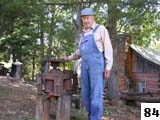 Park). For me, a focal point of the trip is the opportunity to chat with Jack Lombard (Mountain Rest, South Carolina) (Slide 84), an incredible fellow and local legend. He knows almost everything about folklore and what he doesn't know, he is interested in knowing. Indeed, a museum could be lifted from his backyard: want a live rattlesnake? . . .or perhaps a bobcat?. . .an antique tractor? . . .enough implements to operate five two-horse farms? . . or maybe a fully stocked very old cabin is more what you had in mind? Mr. Lombard has it all, including the stories to make it whole. Personally, I liked his apples and bees, and usually I would buy a bushel or two of apples (Yates, if it was late enough) and a little sourwood honey. Times change. Twenty years ago, Oconee County (South Carolina) had 15,000 acres of apples, but now only about 200 acres distributed among ten producers. 2004 (Slide 84) was the last year that Mr. Lombard was in full production. He pulled half of his trees before the 2005 harvest, and now he has none. As he mentioned, at 79, he can't do some of the work now because of three joint replacements. (Of course, he said more, but there's no need to repeat it.) All of this is simply a lead-up to the interesting mill (feed side , spout end ) in his backyard (and a kettle, not shown). Although he is a little harder to catch now that his apple/honey/preserve/relish stand is not open regularly, one is still repaid handsomely for the effort when it is successful. Park). For me, a focal point of the trip is the opportunity to chat with Jack Lombard (Mountain Rest, South Carolina) (Slide 84), an incredible fellow and local legend. He knows almost everything about folklore and what he doesn't know, he is interested in knowing. Indeed, a museum could be lifted from his backyard: want a live rattlesnake? . . .or perhaps a bobcat?. . .an antique tractor? . . .enough implements to operate five two-horse farms? . . or maybe a fully stocked very old cabin is more what you had in mind? Mr. Lombard has it all, including the stories to make it whole. Personally, I liked his apples and bees, and usually I would buy a bushel or two of apples (Yates, if it was late enough) and a little sourwood honey. Times change. Twenty years ago, Oconee County (South Carolina) had 15,000 acres of apples, but now only about 200 acres distributed among ten producers. 2004 (Slide 84) was the last year that Mr. Lombard was in full production. He pulled half of his trees before the 2005 harvest, and now he has none. As he mentioned, at 79, he can't do some of the work now because of three joint replacements. (Of course, he said more, but there's no need to repeat it.) All of this is simply a lead-up to the interesting mill (feed side , spout end ) in his backyard (and a kettle, not shown). Although he is a little harder to catch now that his apple/honey/preserve/relish stand is not open regularly, one is still repaid handsomely for the effort when it is successful.
Postscript: I regret to note that Mr. Lombard died Sep 1, 2014. The loss will be felt by many.
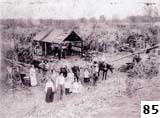 The rich and famous are well remembered, but the real salt of the Earth
make their contributions and pass. This photograph (Slide 85), therefore, means a great deal to me as it shows the former importance of sugar-cane syrup production to "dirt farmers." Taken near Statenville (Georgia), I expect that it was typical of many who lived in less affluent regions of the cane belt. Each time I study the full image I learn something new and try to relate it to my own family's 1-2 acre operation less than 50 miles to the north. (Thanks to Tommy Clayton, who shared this image and its provenance.) The rich and famous are well remembered, but the real salt of the Earth
make their contributions and pass. This photograph (Slide 85), therefore, means a great deal to me as it shows the former importance of sugar-cane syrup production to "dirt farmers." Taken near Statenville (Georgia), I expect that it was typical of many who lived in less affluent regions of the cane belt. Each time I study the full image I learn something new and try to relate it to my own family's 1-2 acre operation less than 50 miles to the north. (Thanks to Tommy Clayton, who shared this image and its provenance.)
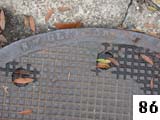
S.W. Gleason, Savannah, GA, produced decorative iron works and sugar-cane equipment, at least kettles. This image of a manhole cover (Slide 86) shows the lasting effects of his foundry on the streets of Savannah.
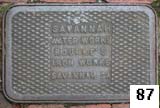 As far as I have seen Gleason equipment (above) is rare--I've seen only a single kettle, part of Tommy and Beth Clayton's collection. In contrast, Rourke kettles and two-roller frameless mills are abundant. Indeed, Rourke and Kehoe kettles are the most common named kettles I have seen. Rourke, like Kehoe, produced a variety of other iron products, such as the water meter cover (Slide 87) and manhole covers. As far as I have seen Gleason equipment (above) is rare--I've seen only a single kettle, part of Tommy and Beth Clayton's collection. In contrast, Rourke kettles and two-roller frameless mills are abundant. Indeed, Rourke and Kehoe kettles are the most common named kettles I have seen. Rourke, like Kehoe, produced a variety of other iron products, such as the water meter cover (Slide 87) and manhole covers.
Introduced to me by their brother-in-law Robert Adams, the Brinkley brothers (Slide 88, l-r, Lonnie, Marvin, Colen, and Brady) near Lake City, FL, host a family- and community-oriented cane grinding each year. They grow a red cane favored by many in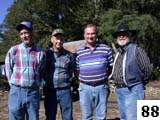 this area, grind on a Chattanooga mill driven by a four-wheeler, and cook in a kettle. An integral part of the event is a lunch "on the grounds," the likes of which I hadn't attended since I was taken around to country churches and family reunions as a child. . . . southern hospitality at the leading edge. I remember, in particular, the collards made by Robert, and that I couldn't get enough of them! As an aside, and not atypically, these syrupmakers involve themselves in other subsistance activities, and for myself as much as for anyone, I have recorded images of their pea sheller (1, 2 , 3). (Thanks to Charles Deese, who lives out from nearby Wellborn, for accompanying me.) this area, grind on a Chattanooga mill driven by a four-wheeler, and cook in a kettle. An integral part of the event is a lunch "on the grounds," the likes of which I hadn't attended since I was taken around to country churches and family reunions as a child. . . . southern hospitality at the leading edge. I remember, in particular, the collards made by Robert, and that I couldn't get enough of them! As an aside, and not atypically, these syrupmakers involve themselves in other subsistance activities, and for myself as much as for anyone, I have recorded images of their pea sheller (1, 2 , 3). (Thanks to Charles Deese, who lives out from nearby Wellborn, for accompanying me.)
Ronnie Gaskins, Weber, GA, stands by his grandfather's mill, a Goldens No. 16x (Slide 89=feed side, discharge side, end view), the only one I have seen as of this writing (2010-11-13), though I own one of the "normal" Goldens No. 16. The No. 16 was still being manufactured as late as 1933, but it appeared that the No. 16x (offered in the 1918 catalog) had been replaced by 1933 by the No. 164x, which is a considerably 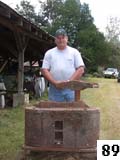 heavier mill (1160 vs. 1550 lbs). Both have two rollers of nominally 16 x 12 inches and an advertised juice capacity of 150 gallons per hour. Although I don't have the weights (and no ready means of getting them), the top plates for the No. 16 and the No. 16x cost exactly the same, implying their similarity. I've seen a number of top plates repaired on the x-series and think that Goldens should have, but did not, compensate for the extra 50% of roller length. I am, perhaps, a little obsessed by the notion of not overfeeding a mill. Now, there's always more to a cane-syrup story than a photo or so of a mill. My mother's father's father's father's (Mark R. Watson) mother and Ronnie's father's father's father's mother's (Malissa Gaskins) mother are the same, Patsey Sirmons. Up until a few decades ago, Ronnie's family and we were neighbors, but now are perhaps three miles away. Ronnie's dad, Walter, was on the Arizona that fateful day, and returned to Berrien County to become sheriff and farmer--he could have been the inspiration for a number of tough John Wayne characters. His grandfather, J. Henry--who owned this mill--was a mover and shaker, legislator, landowner, timberman, farmer, car dealer, boxing promoter, storekeeper, and even a personal banker, indeed, one of the giants in Berrien County history, not surprising, perhaps even expected, for a certain number of descendents of the legendary cattleman, Fisher Gaskins. Mr. J. Henry cooked in a 100-gallon Kehoe kettle (view 1, view 2); note the unusual design of the wood-fired furnance, which had a grate. The syrup operation was set up at Mr. J. Henry's homeplace, but at the time of the photos (2005-11-28), Ronnie lived at the older Gaskins home place nearby, which has a shelter attached to the back. As one would infer from this brief entry, Ronnie has a lot of unmentionable interests. heavier mill (1160 vs. 1550 lbs). Both have two rollers of nominally 16 x 12 inches and an advertised juice capacity of 150 gallons per hour. Although I don't have the weights (and no ready means of getting them), the top plates for the No. 16 and the No. 16x cost exactly the same, implying their similarity. I've seen a number of top plates repaired on the x-series and think that Goldens should have, but did not, compensate for the extra 50% of roller length. I am, perhaps, a little obsessed by the notion of not overfeeding a mill. Now, there's always more to a cane-syrup story than a photo or so of a mill. My mother's father's father's father's (Mark R. Watson) mother and Ronnie's father's father's father's mother's (Malissa Gaskins) mother are the same, Patsey Sirmons. Up until a few decades ago, Ronnie's family and we were neighbors, but now are perhaps three miles away. Ronnie's dad, Walter, was on the Arizona that fateful day, and returned to Berrien County to become sheriff and farmer--he could have been the inspiration for a number of tough John Wayne characters. His grandfather, J. Henry--who owned this mill--was a mover and shaker, legislator, landowner, timberman, farmer, car dealer, boxing promoter, storekeeper, and even a personal banker, indeed, one of the giants in Berrien County history, not surprising, perhaps even expected, for a certain number of descendents of the legendary cattleman, Fisher Gaskins. Mr. J. Henry cooked in a 100-gallon Kehoe kettle (view 1, view 2); note the unusual design of the wood-fired furnance, which had a grate. The syrup operation was set up at Mr. J. Henry's homeplace, but at the time of the photos (2005-11-28), Ronnie lived at the older Gaskins home place nearby, which has a shelter attached to the back. As one would infer from this brief entry, Ronnie has a lot of unmentionable interests.
Marge (nee Watson) and Hansel Morris, Nashville, GA, buck the trend in a number of ways, e.g. by having a successful upscale restaurant for years in Nashville. (The 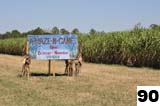 restaurant, Mimi's,was named after Marge's mother.) Now that it is closed, Marge doesn't seem very adept at settling down to retire; she still has a catering business and a French Market, while together, they have started on a fun adventure, a maze (Slide 90) based on sugar cane instead of corn. 2010 is their first year, but they already have a comely "sugar shack," this photo showing Marge and Hansel, with one of their daughters to the right side. They are also setting up a personal area near their pond by renovating an old detached kitchen and a Chattanooga No. 14 cane mill. (Though named Watson (see Snapshot 89), Marge is unrelated to me; her family are newcomers, having moved to Berrien County a century or less ago. As another aside, I enjoyed reminescing with Hansel about "their" rattlesnakes--both his brother and a cousin have been bitten!) restaurant, Mimi's,was named after Marge's mother.) Now that it is closed, Marge doesn't seem very adept at settling down to retire; she still has a catering business and a French Market, while together, they have started on a fun adventure, a maze (Slide 90) based on sugar cane instead of corn. 2010 is their first year, but they already have a comely "sugar shack," this photo showing Marge and Hansel, with one of their daughters to the right side. They are also setting up a personal area near their pond by renovating an old detached kitchen and a Chattanooga No. 14 cane mill. (Though named Watson (see Snapshot 89), Marge is unrelated to me; her family are newcomers, having moved to Berrien County a century or less ago. As another aside, I enjoyed reminescing with Hansel about "their" rattlesnakes--both his brother and a cousin have been bitten!)
|